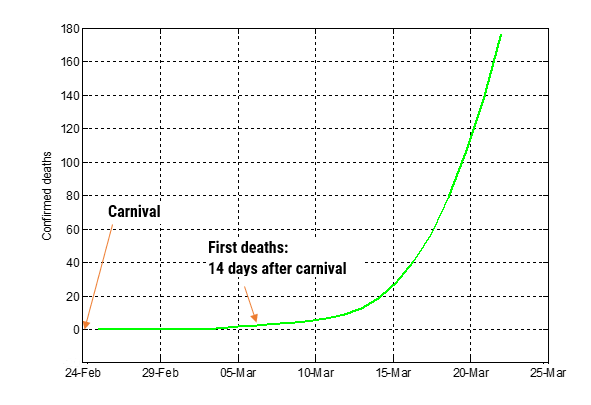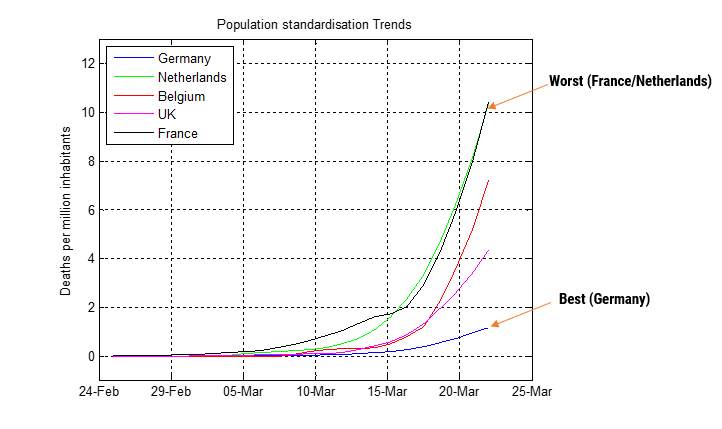The Netherlands is regarded by the International Monetary Fund (IMF) as one the richest countries in the world, with high life expectancy, good infrastructure and a liberal society. The Dutch have historically been traders, learning multiple foreign languages and trading with the whole world – a practice that is still continued to this date. The Dutch love to travel, which may have been one of main factors for the Covid-19 virus gripping the Netherlands so severely.
The Covid-19 virus has led all European governments to effectively lockdown their countries in the hope of limiting the spread of the virus. Although some see this as a violation of their civil rights, the Dutch government’s ambition is to limit the spread of virus so that the health system can cope with a controlled flow of infections.
Population standardisation and carnival
New research from the University of Massachusetts, suggests that the median incubation period (i.e. the time between exposure to the virus and the appearance of the first symptoms) for Covid-19 is just over five days and that 97.5% of people who develop symptoms will do so within 11.5 days of infection.
John Hopkins University (JHU) provide an open database of confirmed cases, deaths and number of recoveries, obtained from data from the World health organisation (WHO), and various other health intuitions and governments. These datasets are broken down into countries and regions.
Applying our ANNA data modelling algorithms to the raw datasets provided by John Hopkins University (JHU), we were able to plot the mortality rate versus time for the Netherlands, as shown below.

Many models are based on raw measured values that are not adjusted for comparison with neighbouring countries, so called population standardisation, which can give a false perspective of the situation at hand.
The yearly Carnival festivals that takes place around the 23-Feb, attracts large crowds of people (shown on the right). This incubation period of approximately 12 days can be clearly seen in the data for the Netherlands, where the first deaths are reported around 7-March (14 days after carnival), suggesting that if not adequately treated in hospital, the patient will die within a few days.

Our analysis considered data obtained from the following five European countries (populations shown in parenthesis): Germany (83 million), the Netherlands (17 million), Belgium (11 million), UK (66 million) and France (67 million).
In order to provide an objective comparison per country, the algorithmic results were standardised around the population of each country in order to produce a deaths per million inhabitants rate. The figure shown below summarises the results.

Analysing the chart, it can be seen that when viewing the scaled dataset, the Netherlands (green) and France (black) have the highest mortality (death) rate, and Germany (blue) the lowest. France’s high mortality rate may be attributed to many foreigners visiting France for their winter holiday.
A disastrous combination of events
Analysing the various news reports, the Brabant province in the South of the Netherlands was a particular hotspot for the virus. Our findings as to the likely reasons why the contagion rate in Brabant is so high can be attributed to a combination of the following factors:
- The yearly Carnival festivals taking place around the 23 February, which attract large crowds of people.
- Frequent foreign travel of people working for large international business, such as Philips and ASML.
- School holiday.
- People taking their winter holidays in France and Italy.
Had carnival taken place several weeks earlier, the effects on the Dutch population may have very well been lower.
Another hotspot for the virus was Amsterdam, which like Brabant is a hub for international business, and a very densely populated region of the country.
Conclusions
The Covid-19 incubation period for the Netherlands is around 12 days.
When standardising the mortality rate population data per million inhabitants with surrounding countries, the Netherlands and France have the highest mortality rate of all of their neighbouring countries. A likely explanation of the explosive outbreak in the Brabant province of the Netherlands, is due to Carnival festival, the school/winter holiday and international business travel. France’s high mortality rate may be attributed to many foreigners visiting France for their winter holiday.
Despite Germany’s large population of 83 million, the data shows that the German government’s handling of the situation has been very effective indeed. The German health system boasts over 25,000 intensive care beds, and respiration equipment. Comparing this this Netherlands, which just has a little over 1,150 beds, and adjusting for the population differences – Germany still has more than 4.5 times more intensive care beds at its desposal.
In terms of prevention: Germany’s National Association of Statutory Health Insurance Physicians, reports that it has capacity for approximately 12,000 Covid-19 tests per day, which surpasses all other European countries.










Leave a Reply
Want to join the discussion?Feel free to contribute!